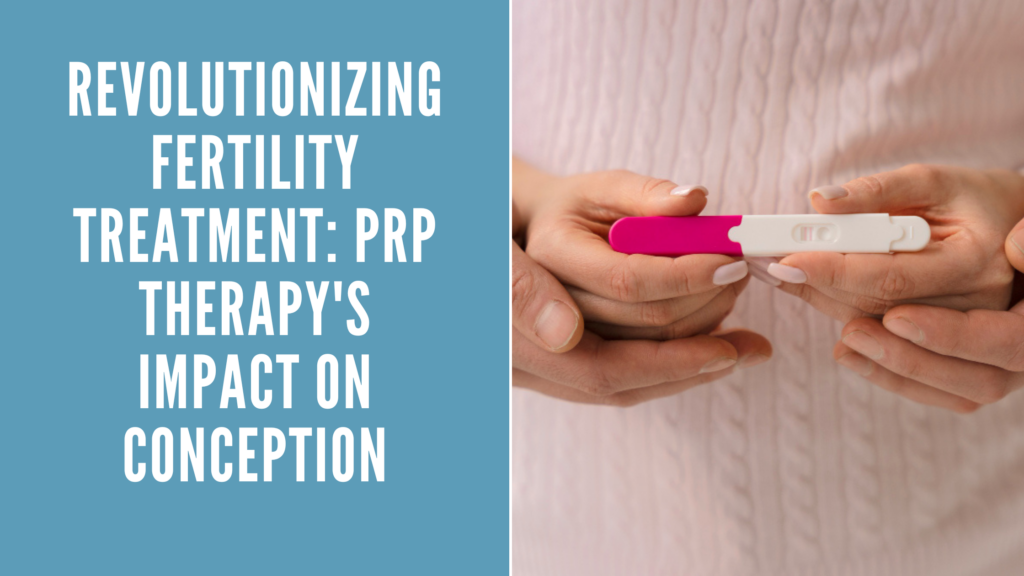
In the world of medical progress, the pursuit of better fertility treatments has witnessed remarkable strides.
For those eager to start families, advancements like Platelet-Rich Plasma (PRP) Therapy for fertility offer renewed hope.
In this blog, we uncover the impact of PRP Therapy on fertility treatment, showcasing how it’s changing the way we approach conception.
What is Intraovarian PRP Therapy?
Intraovarian Platelet-Rich Plasma (PRP) Therapy is a specialized medical procedure that involves injecting platelet-rich plasma directly into the ovaries.
What is PRP treatment for fertility?
PRP treatment for fertility is typically associated with fertility treatments and is sometimes explored as an experimental approach to address certain fertility issues.
PRP is derived from the patient’s own blood and contains a high concentration of platelets. Platelets are known for their benefit of clotting, but they also contain growth factors and other bioactive compounds that can support tissue repair and regeneration.
How Does Intraovarian PRP Therapy Work?
Intraovarian Platelet-Rich Plasma (PRP) Therapy aims to improve ovarian function and potentially enhance fertility through the use of platelet-rich plasma. It is also called as PRP Ovarian Rejuvenation.
During the Intraovarian PRP fertility treatment, a small amount of blood is drawn from the patient, which is then processed in a machine called a centrifuge to separate the platelets and plasma from other blood components.
The resulting platelet-rich plasma is carefully injected into the ovaries. The growth factors and bioactive substances in PRP help to promote the growth and development of ovarian follicles, which contain immature eggs.
What are the Potential Benefits of Intraovarian PRP Therapy?
Intraovarian PRP therapy has potential benefits as a fertility treatment. Here are some of them:
- Improved ovarian function: The growth factors and bioactive molecules present in PRP could potentially stimulate and enhance ovarian function. This might include promoting the development of ovarian follicles and improving their responsiveness to hormonal signals.
- Enhanced fertility: By stimulating the growth of ovarian follicles, PRP therapy may improve fertility and increase the chances of successful conception by promoting the development of more healthy eggs in the ovaries.
- Increased response to ovarian stimulation: In cases where a woman is undergoing fertility treatments such as In Vitro Fertilization (IVF), Intraovarian PRP Therapy may improve the success rate of these procedures.
Is Intraovarian PRP Therapy safe?
Intraovarian PRP Therapy is a safe procedure and involves injecting plasma into the ovaries using the same equipment used for egg retrieval during an IVF procedure.
Since PRP is derived from the patient’s own blood, there is minimal risk of adverse reactions or complications. However, as with any medical procedure, slight risks may be involved, such as bleeding, infection, or temporary discomfort at the injection site.
Despite the above-noted potential benefits, it should be noted that this is a recently introduced procedure and is still being evaluated.
If you are considering intraovarian PRP therapy as a potential fertility treatment, it’s crucial to consult with a qualified fertility specialist and discuss the potential risks and benefits of the therapy.
What can I expect during the Intraovarian PRP Therapy procedure?
The PRP therapy begins with an initial consultation with a reproductive endocrinologist or fertility specialist. Your medical history, fertility concerns, and treatment options will be discussed during this consultation.
- Blood sample: The procedure typically starts with collecting a small amount of your blood, similar to a standard blood draw. The plasma pulled from the blood sample collected will be used to stimulate the growth of new and existing eggs.
- Centrifugation: The collected blood would be processed in a centrifuge, a machine to isolate the platelet-rich plasma (PRP) from the rest components of your blood.
- Prepping the PRP: The PRP is carefully extracted and prepared for injection. It’s concentrated with growth factors and other compounds that are believed to have potential regenerative properties.
- PRP injection: The PRP is carefully injected into the ovaries directly using guidance for precision.
After the procedure, you might be observed for a short period to ensure there are no immediate adverse reactions. You could be able to go home on the same day, and you will be advised to rest on the day of the procedure.
You may have follow-up appointments to monitor your progress and assess the impact of the therapy on your ovarian function and fertility.
Visit Oasis Fertility Centre for PRP Fertility Treatment.
For information on how Oasis Fertility Centre offers Intraovarian PRP, read more about it here:
Intraovarian Platelet Rich Plasma (PRP) Infusion
Oasis Fertility Centre team of qualified fertility specialists will provide you with a personalized approach to an emotional, vulnerable, and financially challenging journey to parenthood.
Dr. Imran Pirwany is among the select few doctors in Calgary, Alberta, and nearby areas like Red Deer, Edmonton, and more, offering PRP – Platelet-rich Plasma as a potential solution for infertility. Serving various communities including High River, Medicine Hat, Lethbridge, Drayton Valley, Edson, Lacombe, and Drumheller



